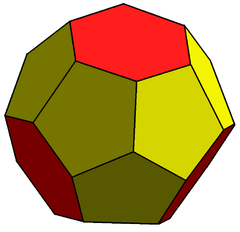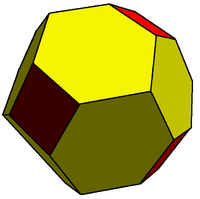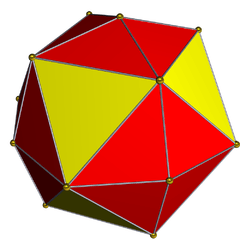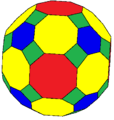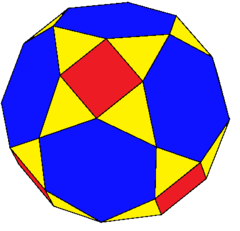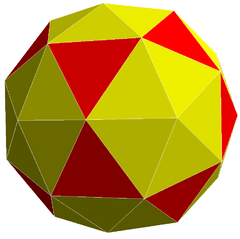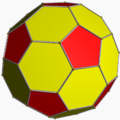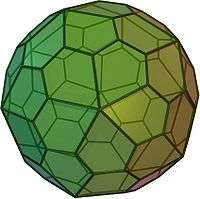Conway polyhedron notation


Conway polyhedron notation is used to describe polyhedra based on a seed polyhedron modified by various operations.
The seed polyhedra are the Platonic solids, represented by the first letter of their name (T,O,C,I,D); the prisms (Pn), antiprisms (An) and pyramids (Yn). Any convex polyhedron can serve as a seed, as long as the operations can be executed on it.
John Conway extended the idea of using operators, like truncation defined by Kepler, to build related polyhedra of the same symmetry. His descriptive operators can generate all the Archimedean solids and Catalan solids from regular seeds. Applied in a series, these operators allow many higher order polyhedra to be generated.
Operations on polyhedra
Elements are given from the seed (v,e,f) to the new forms, assuming seed is a convex polyhedron: (a topological sphere, Euler characteristic = 2) An example image is given for each operation, based on a cubic seed. The basic operations are sufficient to generate the reflective uniform polyhedra and theirs duals. Some basic operations can be made as composites of others.
Special forms
- The kis operator has a variation, kn, which only adds pyramids to n-sided faces.
- The truncate operator has a variation, tn, which only truncates order-n vertices.
The operators are applied like functions from right to left. For example a cuboctahedron is an ambo cube, i.e. t(C) = aC, and a truncated cuboctahedron is t(a(C)) = t(aC) = taC.
| Operator | Example | Name | Alternate construction | vertices | edges | faces | Description | |
|---|---|---|---|---|---|---|---|---|
 | Seed | v | e | f | Seed form | |||
| d |  | dual | f | e | v | dual of the seed polyhedron - each vertex creates a new face | ||
| a |  | ambo | e | 2e | 2 + e | New vertices are added mid-edges, while old vertices are removed. (rectify) | ||
| j |  | join | da | e + 2 | 2e | e | The seed is augmented with pyramids at a height high enough so that 2 coplanar triangles from 2 different pyramids share an edge. | |
| t |  | truncate | dkd | 2e | 3e | e + 2 | truncate all vertices. conjugate kis | |
| k |  | kis | dtd | e + 2 | 3e | 2e | raises a pyramid on each face. | |
| i |  | -- | dk | 2e | 3e | e + 2 | Dual of kis. (bitruncation) | |
| n |  | -- | kd | e + 2 | 3e | 2e | Kis of dual | |
| e |  | expand | aa = aj | 2e | 4e | 2e + 2 | Each vertex creates a new face and each edge creates a new quadrilateral. (cantellate) | |
| o |  | ortho | de = ja = jj | 2e + 2 | 4e | 2e | Each n-gon faces are divided into n quadrilaterals. | |
| b |  | bevel | ta | 4e | 6e | 2e + 2 | New faces are added in place of edges and vertices. (cantitruncation) | |
| m |  | meta | db = kj | 2e + 2 | 6e | 4e | n-gon faces are divided into 2n triangles | |
Extended operators
These extended operators can't be created in general from the basic operations above. Some can be created in special cases with k and t operators only applied to specific sided faces and vertices. For example a chamfered cube, cC, can be constructed as t4daC, as a rhombic dodecahedron, daC or jC, with its valence-4 vertices truncated. And a quinto-dodecahedron, qD can be constructed as t5daaD or t5deD or t5oD, a deltoidal hexecontahedron, deD or oD, with its valence-5 vertices truncated.
| Operator | Example | Name | Alternate construction | vertices | edges | faces | Description | |
|---|---|---|---|---|---|---|---|---|
 | Seed | v | e | f | Seed form | |||
| c |  | chamfer | v + 2e | 4e | f + e | An edge-truncation. New hexagonal faces are added in place of edges. | ||
| - |  | - | dc | f + e | 4e | v + 2e | Dual of chamfer | |
| q |  | quinto | v+3e | 6e | f+2e | Ortho followed by truncation of vertices centered on original faces. This create 2 new pentagons for every original edge. | ||
| - |  | - | dq | f+2e | 6e | v+3e | Dual of quinto | |
Chiral extended operators
These extended operators can't be created in general from the basic operations above. The gyro/snub operations are needed to generate the uniform polyhedra and duals with rotational symmetry.
Geometric artist George W. Hart created an operation he called a propellor, and another reflect to create mirror images of the rotated forms.
- p – "propellor" (A rotation operator that creates quadrilaterals at the vertices). This operation is self-dual: dpX=pdX.
- r – "reflect" – makes the mirror image of the seed; it has no effect unless the seed was made with s or g.
The half operator, h, from Coxeter, reduces square faces into digons, with two coinciding edges, which may or may not be replaced by a single edge. If digons remain, subsequently truncation operations can expand digons into square faces.
| Operator | Example | Name | Alternate construction | vertices | edges | faces | Description | |
|---|---|---|---|---|---|---|---|---|
 | Seed | v | e | f | Seed form | |||
| r | reflect (Hart) |
v | e | f | Mirror image for chiral forms | |||
| h |  | half * | v/2 | e | f+v/2 | Alternation, remove half vertices, limited to seed polyhedra with even-sided faces | ||
| p |  | propellor (Hart) |
v + 2e | 5e | f + 2e | A face rotation that creates quadrilaterals at vertices (self-dual) | ||
| - |  | - | dp = pd | f + 2e | 5e | v + 2e | ||
| s |  | snub | dg = hta | 2e | 5e | 3e + 2 | "expand and twist" – each vertex creates a new face and each edge creates two new triangles | |
| g |  | gyro | ds | 3e + 2 | 5e | 2e | Each n-gon face is divided into n pentagons. | |
| w |  | whirl | v+4e | 7e | f+2e | Gyro followed by truncation of vertices centered on original faces. This create 2 new hexagons for every original edge | ||
| - |  | - | dw | f+2e | 7e | v+4e | Dual of whirl | |
Generating regular seeds
All of the five regular polyhedra can be generated from prismatic generators with zero to two operators:
- Triangular pyramid: Y3 (A tetrahedron is a special pyramid)
- T = Y3
- O = aY3 (ambo tetrahedron)
- C = jY3 (join tetrahedron)
- I = sY3 (snub tetrahedron)
- D = gY3 (gyro tetrahedron)
- Triangular antiprism: A3 (An octahedron is a special antiprism)
- O = A3
- C = dA3
- Square prism: P4 (A cube is a special prism)
- C = P4
- Pentagonal antiprism: A5
- I = k5A5 (A special gyroelongated dipyramid)
- D = t5dA5 (A special truncated trapezohedron)
The regular Euclidean tilings can also be used as seeds:
- Q = Quadrille =Square tiling
- H = Hextille = Hexagonal tiling = dΔ
- Δ = Deltille = Triangular tiling = dH
Examples
The cube can generate all the convex uniform polyhedra with octahedral symmetry. The first row generates the Archimedean solids and the second row the Catalan solids, the second row forms being duals of the first. Comparing each new polyhedron with the cube, each operation can be visually understood. (Two polyhedron forms don't have single operator names given by Conway.)
| Cube "seed" |
ambo | truncate | bitruncate | expand | bevel |
|---|---|---|---|---|---|
 C |
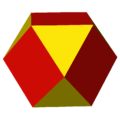 aC = djC |
 tC = dkdC |
 tdC = dkC |
 eC = aaC = doC |
 bC = taC = dmC = dkjC |
| dual | join | dual truncate | kis | ortho | meta |
 dC |
 jC |
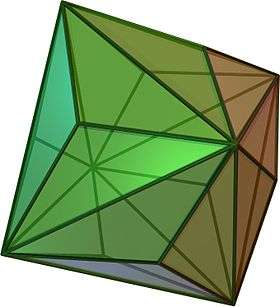 kdC = dtC |
 kC |
 oC |
 mC |
| Extended operations | |||||
| snub | propellor | chamfer | whirl | ||
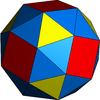 sC |
 pC |
 cC |
 wC | ||
| gyro | dual propeller | dual chamfer | dual whirl | ||
 gC = dsC |
 dpC |
 dcC |
 dwC | ||
 T |
 tT |
 aT |
 tdT |
 eT |
 bT |
 sT |
 dT |
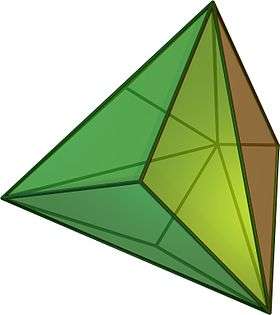 dtT |
 jT |
 kT |
 oT |
 mT |
 gT |
The truncated icosahedron as a nonregular seed creates more polyhedra which are not vertex or face uniform.
| "seed" | ambo | truncate | bitruncate | expand | bevel |
|---|---|---|---|---|---|
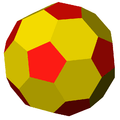 tI |
 atI |
 ttI |
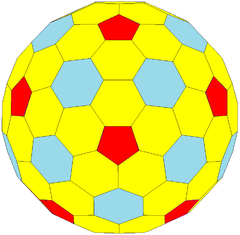 tdtI |
 etI |
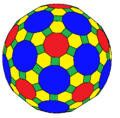 btI |
| dual | join | kis | ortho | meta | |
 dtI |
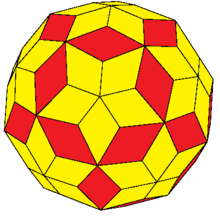 jtI |
 kdtI |
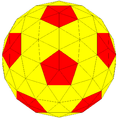 ktI |
 otI |
 mtI |
| Extended operations | |||||
| snub | propellor | chamfer | quinto | whirl | |
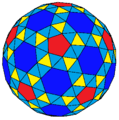 stI |
 ptI |
 ctI |
 qtI |
 wtI | |
| gyro | dual propeller | dual chamfer | dual quinto | dual whirl | |
 gtI |
 dptI |
 dctI |
 dqtI |
 dwtI | |
Geometric coordinates of derived forms
In general the seed polyhedron can be considered a tiling of a surface since the operators represent topological operations so the exact geometric positions of the vertices of the derived forms are not defined in general. A convex regular polyhedron seed can be considered a tiling on a sphere, and so the derived polyhedron can equally be assumed to be positioned on the surface of a sphere. Similar a regular tiling on a plane, such as a hexagonal tiling can be a seed tiling for derived tilings. Nonconvex polyhedra can become seeds if a related topological surface is defined to constrain the positions of the vertices. For example toroidal polyhedra can derive other polyhedra with point on the same torus surface.
Spherical examples
 D |
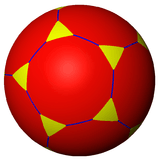 tD |
 aD |
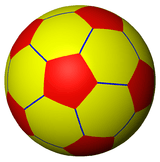 tdD |
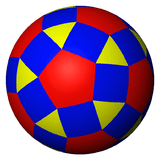 eD |
 taD |
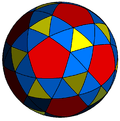 sD |
 dD |
 dtD |
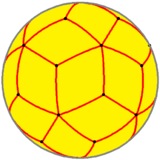 daD = jD |
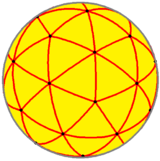 dtdD = kD |
 deD = oD |
 dtaD = mD |
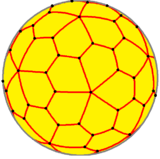 gD |
Euclidean examples
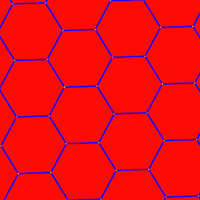 H |
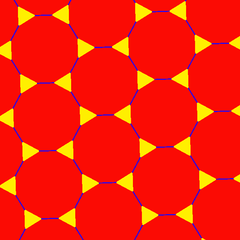 tH |
 aH |
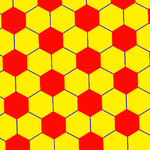 tdH = H |
 eH |
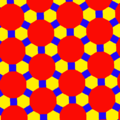 taH = bH |
 sH |
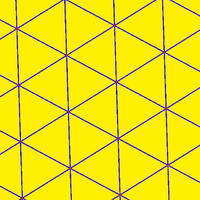 dH |
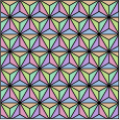 dtH |
 daH = jH |
 dtdH = kH |
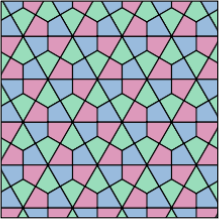 deH = oH |
 dtaH = mH |
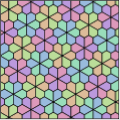 dsH = gH |
Hyperbolic examples
| {7,3} "seed" |
truncate | ambo | bitruncate | expand | bevel | snub |
|---|---|---|---|---|---|---|
 |
 |
 |
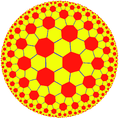 |
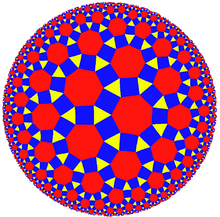 |
 |
 |
| dual | dual kis | join | kis | ortho | meta | gyro |
 |
 |
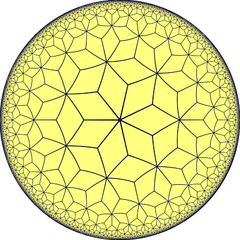 |
 |
 |
 |
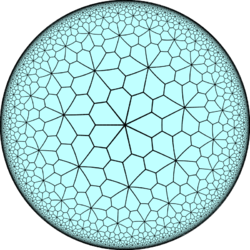 |
Other polyhedra
Iterating operators on simple forms can produce progressively larger polyhedra, maintaining the fundamental symmetry of the seed element. The vertices are assumed to be on the same spherical radius. Some generated forms can exist as spherical tilings, but fail to produce polyhedra with planar faces.
Tetrahedral symmetry
-
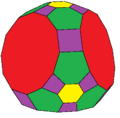
tatT
-

stT
Octahedral symmetry
-

dk4sC
-

t3daC
-

saC
-
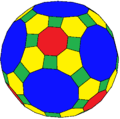
tatO
-

stO
-
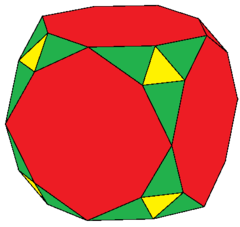
atC
-

tatC
-

stC
-

daC
-
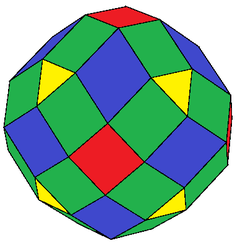
edaC
-

gaC
-
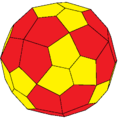
saC
Icosahedral symmetry
-

saD
-

tatI
-

stI
-

atD
-

tatD
-

stD
-

daD
-
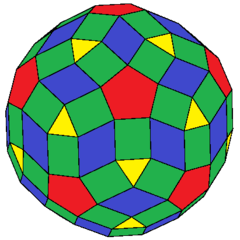
edaD
-

gaD
-

saD
-

atkD
-

actI
Rhombic:
-
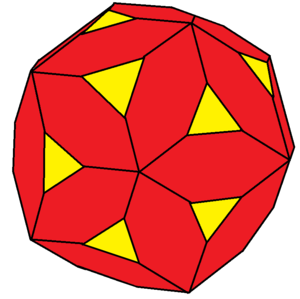
t3daD
Triangular:
-

k6k5tI
-

kt5daD
-
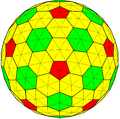
kdktI
-
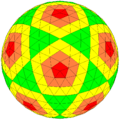
kdkt5daD
Dual triangular:
-

dk6k5tI
-
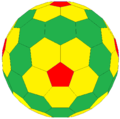
dkt5daD
-

tktI
-

tkt5daD
Triangular chiral:
-
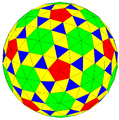
k5k6stI=kdk5sD
Dual triangular chiral:
-

sD
-
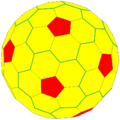
dk5sD
-

dk5k6stI=tk5sD
Dihedral symmetry
-

t4daA4=cA4
-

t4daA4=cA4 (side)
-

t4daA4=cA4 (top)
-

tA4
-
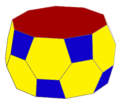
tA5
-
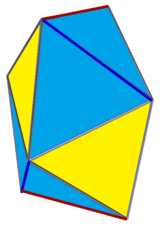
ssA2
-
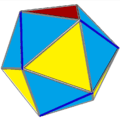
ssA3=I
-

ssA4
-

ssA5
-

aaP3
-
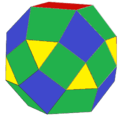
aaA4
See also
- Uniform polyhedra
- Computer graphics algorithms:
- Doo–Sabin subdivision surface – expand operator
- Catmull–Clark subdivision surface – ortho operator
- Goldberg polyhedron
References
- George W. Hart, Sculpture based on Propellorized Polyhedra, Proceedings of MOSAIC 2000, Seattle, WA, August, 2000, pp. 61–70
- John H. Conway, Heidi Burgiel, Chaim Goodman-Strass, The Symmetries of Things 2008, ISBN 978-1-56881-220-5
- Chapter 21: Naming the Archimedean and Catalan polyhedra and Tilings
External links and references
- George Hart's Conway interpreter: generates polyhedra in VRML, taking Conway notation as input. Also includes helpful explanations of the operations.
- Vertex- and edge-truncation of the Platonic and Archimedean solids leading to vertex-transitive polyhedra Livio Zefiro
- polyHédronisme: generates polyhedra in HTML5 canvas, taking Conway notation as input
- Weisstein, Eric W. "Conway Polyhedron Notation". MathWorld.
(truncate)
(ambo)
(kis)
